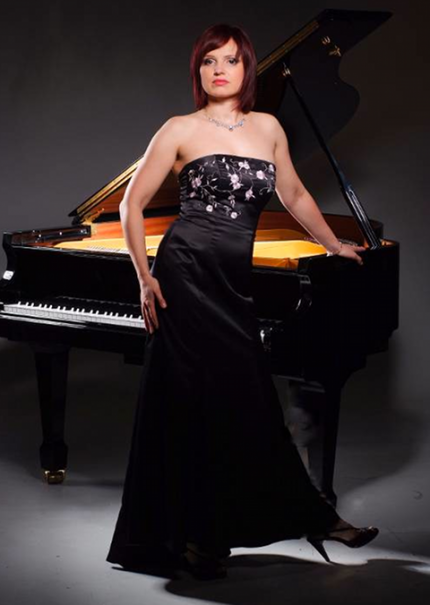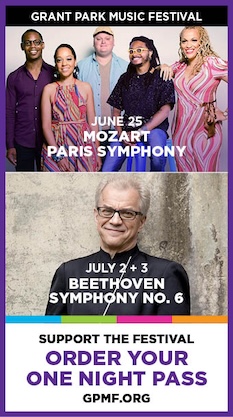How to stuff a wild Beethoven Festival
The best way to experience the dauntingly ambitious and wildly packed Beethoven Festival is to do a full immersion if possible and try to hit as many events as possible in a single day and night. The introductions by pianist/artistic director George Lepauw and other performers set the scene and there is a relaxed salon-like informality about the proceedings that invites longer listening sessions.
The festival, which runs through Sunday, has decamped from the scruffy Uptown theater last year to the more respectable confines of the Merit School of Music on the Near West side. That makes this year’s events more accessible from downtown, though parking is frustrating for urbanites who chafe at the legally sanctioned armed robbery of Chicago meters. (Note: get there early and explore the blocks surrounding Merit—there is free street parking to be found.)
This year’s theme is “LOVE,” the emotion that imbues so much of Beethoven’s music, yet that proved elusive in his private life. (Most of the composer’s romances consisted of short-lived infatuations with disinterested women above his social station.)
As always, there is a strong visual art component—once again curated by festival art director and New York gallery owner Catinca Tabacaru—such as the funkified Merit recital hall and anatomically correct chambered heart above the stage.
There is also a prominent fashion element this year, something largely inscrutable to the unfashionable musical press. Models in designer outfits provided fetching albeit extraneous eye candy though having them strike saucy poses around the piano during an actual performance recalled the River City Ladies Club’s “Ode to a Grecian Urn” tableau in The Music Man.
If the when-arts-worlds-collide eclecticism has its goofy moments, it’s part of the festival’s off-center appeal, which somehow seems apt for Beethoven. After all the composer who gave the world the Missa Solemnis is the same opportunist who turned out the puerile Wellington’s Victory.
I took in most of Sunday’s events from pianist Nicholas Roth’s early Beethoven program to Dal Niente’s evening season-opener of thorny contemporary works.
As in previous festival installments, the level of performance was consistently high, the range of repertoire wide and audacious. Perhaps most importantly, the audiences were significantly larger than last year, which bodes well for the future of Lepauw’s International Beethoven Project.
One of the most gratifying elements of the Beethoven Festival is the opportunity to encounter new artists that one rarely hears in Chicago. Such was the case with the afternoon recital by pianist Katarzyna Musial, which was the clear highlight of the day’s events.
Born in Poland and resident in Canada, Musial is a major talent, blessed with an astounding technique and an interpretive panache that delivered compelling advocacy for Spanish music and that of her compatriots.
Oddly, apart from an impassioned Revolutionary Etude, her Chopin set was a bit anodyne, with rather literal accounts of the composer’s waltzes that lacked lightness and charm. Her plain-spun take on Messiaen’s Prelude “La Combe” was similarly faceless.
Musial proved a sterling advocate however for 20th-century Polish music. Lutoslawski’s Bukoliki danced with joyous abandon, the pensive middle section adding piquant contrast. And Musial found the moody edge and embryonic originality beneath the Chopin and Bartok influences in Henryk Gorecki’s Opus 1, the Four Preludes.
Most impressive was her Spanish set. The pianist romped through piano works by Ginastera, Lecuona and Turina with swaying rhythms, elastic rubato and dazzling bravura.
As a finale, Musial was joined by conductor Daniel Black and a small string ensemble for Gorecki’s Harpsichord Concerto. The short two-movement work is a bit of a trifle and, while the composer sanctioned performances on a concert grand as was done here, the Neo-Baroque element and ear-tickling timbres of the original version tend to get lost. Still, Musial and colleagues served up a vital and engaging performance segueing from the fractured Romanticism of the opening movement to the driving moto perpetuo of the finale with a notably fiery and thrilling coda.
Earlier, the festival offered a singular event with what was billed as a Beethoven world premiere.
The Wisconsin-based Beethoven scholar Mark Zimmer unearthed a version of Liebe, a Beethoven song that is in the Hess catalogue but was viewed with suspicion. An alternative score, uncovered by Zimmer, was subsequently authenticated.
The song title fits the festival theme—“We commissioned it,” Lepauw joked—-and certainly sounds like genuine Beethoven, some awkward transitions apart. (Also whether the puritanical Beethoven would have set music to a text with ribald banana references is open to question.) Still, if no masterpiece, it’s an attractive work, and received an ardent performance by Armstrong and Lepauw.
Armstrong is an engaging presence and the young tenor showed his mettle in a generous program. His light voice is somewhat shallow at the top and he sounded dry at times in the close acoustic though sang with warmer tone as the program unfolded.
The tenor led off with a graceful rendering of Adelaide, Beethoven’s most famous song, as well as an expressive and passionate account of the song-cycle An die ferne geliebte (To the Distant Beloved).
Armstrong and Lepauw also offered a searching performance of Britten’s Michelangelo Songs and a winning set of Roger Quilter settings—“I love schmaltz” said the tenor—that brought out the wistful romantic charm.
Fortissimos in the piano and vocalism were occasionally overwhelming for the small room and artists may want to take louder dynamics down a notch. Less excusable was the complete lack of texts or even song titles for the Beethoven and Britten cycles.
Before the dinner break, there was a surreal interval in which the models in designer garb stood immobile atop pedestals of varying heights, This presentation was greeted with hushed silence by the audience who seemed strangely respectful or completely baffled by the unexpected visuals.
After dinner, the proceedings took a decisive turn for the modern with Ensemble Dal Niente’s program of Stockhausen and Thomalla. It was gratifying that the event with the most uncompromising music drew the largest audience of the day with a quorum of young people and hipsters listening transfixed to these works.
Completed in 1960, Karlheinz Stockhausen’s Kontakte is among the German modernist’s most celebrated electronic works. Scored for pianist, percussionist, electronica and a massive array of percussion instruments, it is also a spatial work with four speakers placed in the corner of the Merit School’s main concert hall.
Despite Stockhausen’s forbidding reputation for gnarly 1960s atonality, Kontakte is consistently compelling, a 35-minute sonic roller-coaster.
Granted, some of the crashing sounds and plugged-in burbling suggests either electroacoustic gastrointestinal distress or a terrible accident on the Autobahn.
Yet there was also extraordinary delicacy in the variegated array of hues, sounds and effects. This difficult work was scrupulously prepared and technically immaculate. Percussionist Gregory Beyer, pianist (doubling on percussion) Mabel Kwan and electronicist Francisco Castillo Trigueros delivered a performance of stunning virtuosity, musicality and resourcefulness that was almost as enjoyable to watch as to hear, the three receiving the loudest ovation of the day.
Oddly, it was Hans Thomalla’s The Brightest Form of Absence that proved the one clinker Sunday. Heard in its Chicago premiere, Thomalla’s work calls for soprano, video, electronics and large ensemble (players arrayed along the sides and back of the hall).
The work was inspired by the quiet, ephemeral sounds of the empty Mojave desert, represented on the high-def video as various objects (a bucket, a bottle) are dragged on strings through the desert landscape.
Unfortunately the visuals reflected Thomalla’s arid and formless work, which seemed to go on forever, and felt more like a musty academic artifact of the 1960s than the bracing, inventive music of the much-abused Stockhausen.
I started the day with Nicholas Roth’s program of three Beethoven piano sonatas. All concise works in two movements each, Roth’s straightforward style was attuned to the relaxed bonhomie of the first two, though at times one wanted more dynamic detailing. Op. 21 came off best, contrasts firmly pointed and the closing Allegretto thrown off with a burst of adrenaline at the coda.
The Beethoven Festival continues through September 15. beethovenfestival2013.com
Posted in Performances


